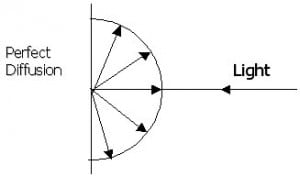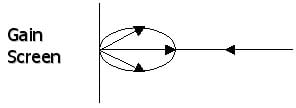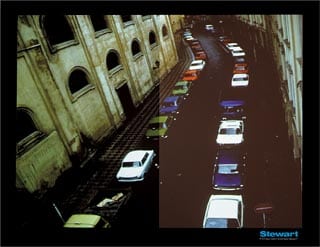Projection Screen Terminology and Advice: Factors in deciding which projector screen is right for you.
Projector Reviews thanks Stewart Filmscreen Corp. - the first sponsor of our All About Projector Screens section, for providing multiple useful articles on screens, screen terminology and how to select the best screen for your requirements.
Screen Gain, Half Gain & Viewing angles…
Gain is the industry term used to measure the amount of light reflecting from a screen surface. No actual light “gain” takes place. Gain measures the screen brightness and directional characteristics. Matte White or unity gain is usually 1.0 gain. The standard measurement for calibration is magnesium carbonate. Half Gain is the standard used to measure the brightness performance of a projection screen when the viewer is observing the screen from an extreme angle or “off to the side”. A projection screen’s peak brightness occurs when the viewer is perpendicular to the center of the screen. As the viewer moves out to the side, away from the center of the screen, the brightness of the image will deteriorate. When the brightness drop off reaches 50% of the peak gain, that determines the screen’s half gain (or half brightness). For the best image, the picture should not be viewed at angles greater than 45% off center or outside a 90 degree seating cone.
High & Low Gain Screens…
High lumen output projectors should be matched with lower gain screen surfaces to minimize hotspot artifacts, increase resolution & viewing angles. Projectors with low lumen outputs can be improved with a quality Stewart high gain screen. Brightness is retrieved and the image emerges even when ambient light can not be completely controlled . Contact your projector company for required information pertaining to image size, focal length of lens and ANSI lumen output.
Angular Reflective Screens…
All Stewart Screens are “Angular Reflective”. This means that the projected light reflects off the screen in an angular way (same angle at which it hits the screen surface). For example, a video projector mounted on ceiling, the peak light bounces towards the audience.
------------------------------------------
Matte White Screen 1.0 Gain

-------------------------------------------
Angular Reflective Screen 1.3 Gain

-------------------------------------------
Angular Reflective or Retro Reflective 2.0+ Gain

Uniformity
Uniformity refers to not only how the screen displays an image, but also how well the projector is projecting the image. Traditionally, screen measurements are made by pointing a light metering device at the center of the screen. This is good information, but it only tells how bright a screen's center will appear from different viewing angles ranging from 0 to 180 degrees. Information and images on the edges may lose light. Projection screens have very uniform coatings, but the projectors may not luminate perfectly uniform. The combination of the type of projector, the length of the lens, the distance the projector is to the screen, and the screen itself will ultimately determine image quality. Optical coating also helps in creating light uniformity, it scatters light rays producing a more uniform image.
Contrast
Contrast is the difference between light and dark areas. Contrast depends on the ratio between the maximum & minimum light levels within any image. It is calculated by dividing the peak white levels by the light level at the darkest part of the picture. Measurements are taken at the peak white and an area of black near the white. Blacks are never really true black in color, they are shades of dark gray. This is because projectors do not produce the color black. Black is perceived in the areas of the image in which the projector produces no light output. If you turn on room lighting during a presentation, contrast is lost, and once vibrant colors and shading now appear lifeless and faded. With a Stewart gray screen, you can achieve deep blacks, high contrast, and vibrant color even with additional light in the room. Stewart Filmscreen now manufactures three products specifically directed to installations with high ambient light levels. Grayhawk & FireHawk are high contrast, enhanced black level, front projection materials. Graphite is a rigid rear projection screen with optimized contrast and excellent ambient light rejection.
Image shown in modest ambient light conditions.The matte surface image washes out, the high contrast Firehawk surface does not.
 Click Image to Enlarge
Click Image to Enlarge




